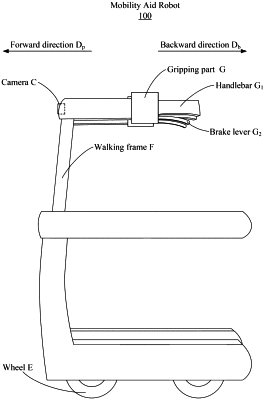| CPC G05D 1/0212 (2013.01) [A61H 3/04 (2013.01); G05D 1/0246 (2013.01); G06T 7/251 (2017.01); G06V 20/58 (2022.01); G06V 40/103 (2022.01); A61H 2003/043 (2013.01)] | 18 Claims |

|
1. A method for navigating a mobility aid robot to a user for performing a specified task on the user, wherein the robot has a camera and at least a gripping part disposed toward different directions, and the method comprises:
identifying, through the camera, a posture of the user, and wherein the posture of the user comprises: a standing posture, a sitting posture and a lying down posture;
determining a mode of the robot according to a type of the specified task to be performed on the user and the identified posture of the user, and wherein a type of the specified task comprises: an assisting type and a greeting type;
controlling the robot to move according to a planned trajectory corresponding to the determined mode of the robot, wherein the trajectory comprises a sequence of poses, and the last of the sequence of poses is a desired pose; and
turning the robot upon reaching the desired pose such that the gripping part faces the user, in response to the determined mode of the robot corresponding to the specified task of the assisting type and the user at one of the standing posture and the sitting posture;
wherein in response to the specified task to be performed on the user being the assisting type, and the user being at the sitting posture, the method further comprises:
determining a facing direction of the user; and
determining whether there is an obstacle positioned in the facing direction of the user, and obtaining a determining result, wherein the mode of the robot is determined according to the type of the specified task to be performed on the user, the identified posture of the user, and the determining result;
wherein after the determining whether there is the obstacle positioned in the facing direction of the user, the method further comprises:
planning the trajectory such that the desired pose is positioned with a first distance to the user, in response to the determined mode of the robot corresponding to the specified task of the assisting type, the user at the sitting posture, and there being the obstacle positioned in the facing direction of the user; and
planning the trajectory such that the desired pose is positioned in the facing direction of the user, in response to the determined mode of the robot corresponding to the specified task of the assisting type, the user at the sitting posture, and there being no obstacle positioned in the facing direction of the user.
|